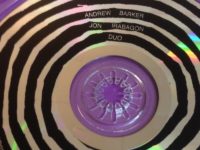Brooklyn-based guitarist Gene Segal was already well on his way to developing his own voice when he issued the organ jazz-based debut Hypnotic five years ago. Back then, he was already breaking outside of normal conventions on the strength of his open-ended compositions. Mental Images (May 10, 2014 via SteepleChase Productions) goes a step further by dispensing with a keyboard altogether, putting more of the harmonic load on his guitar, which also opens up more possibilities for him.
Using a completely different backing band, Mental Images uses this limitation — and the limitations imposed by there being only so many notes — as a catalyst for being more creative out of necessity. He starts with a skeletal rhythm section of Sean Conly (acoustic bass) and Jaimeo Brown (drums), adding either Jon Irabagon (alto sax) or Sam Sadigursky (various other reeds) as the song requires.
Actually, Irabagon and Sadigursky do join forces for one song, the organically funky “Healing Feeling.” Irabagon kicks off a round of solos, reaching deep to make his expressions count. When Segal’s turn comes, it’s remarkable how him and Brown are so closely connected they are to each other. In a way, this leadoff groover is not indicative of the rest of the album, but the interesting counter harmonies provided by Irabagon and Sadigursky during the head provides clues about the composition style of Segal more apparent over the rest of the album.
Much of Segal’s songs are brooding, cerebral and pliable, ably making any argument of whether it’s truly jazz or fusion instead largely superfluous. “Allegory of the Cave”, carried out in a loose 3/4 cadence, features Irabagon but is down to a trio for much of the song, where the guitarist ably comps and leads at the same time over an esoteric melody. He brings that same trait to “The Bearded Lady,” a mid-tempo march which ends with a rock-heavy figure complemented by Brown’s explosions. “Minds Eye” and “Irrational Drives” build on ostinatos instigated by Sadigursky (bass clarinet) and Conly, respectively. On the former, Segal offers up a counter-melody and on the latter, he and Irabagon venture outside a little as they solo together in some inspired tension release.
By the time we reach the “The Ringmaster,” we realize how far outside ordinary jazz Segal had strayed, because this is the first and only overtly swinging song. Nonetheless, when Segal solos, he sounds more like John Scofield than Jim Hall. He concludes the album with a side-alley excursion of an entirely different sort: “Elephants” is doom metal jazz, with Sadigursky’s tenor sax sometimes acting as a second, harmonizing guitar. As Sadigursky improvises, Segal can be heard letting loose some creepy noises from his guitar.
It was a long stretch between the first and second albums but Mental Images assures that the intervening time was time was spent.
- Ivo Perelman, Ken Vandermark + Joe McPhee – ‘Oxygen’ (2025) - March 3, 2025
- Jeff Arnal + Dietrich Eichmann – ‘Tides of Unrest / Berlin 2023’ (2025) - February 26, 2025
- Matthias Muller + Andreas Willers – ‘Matthias Muller Andreas Willers’ (2025) - February 25, 2025




